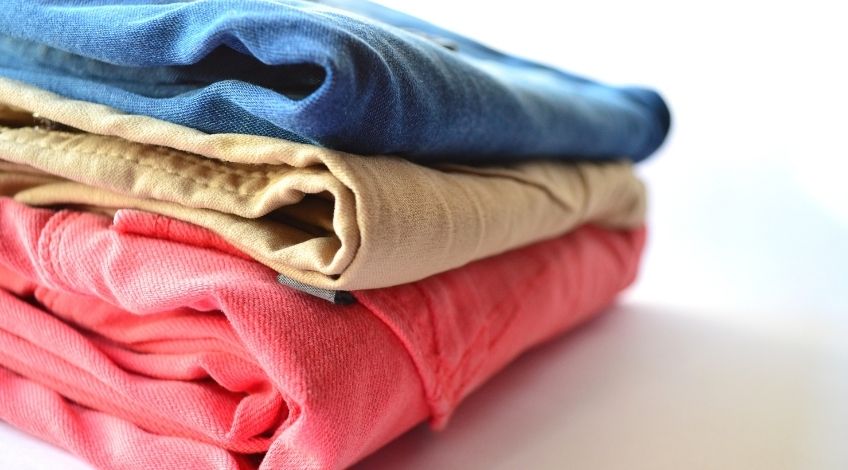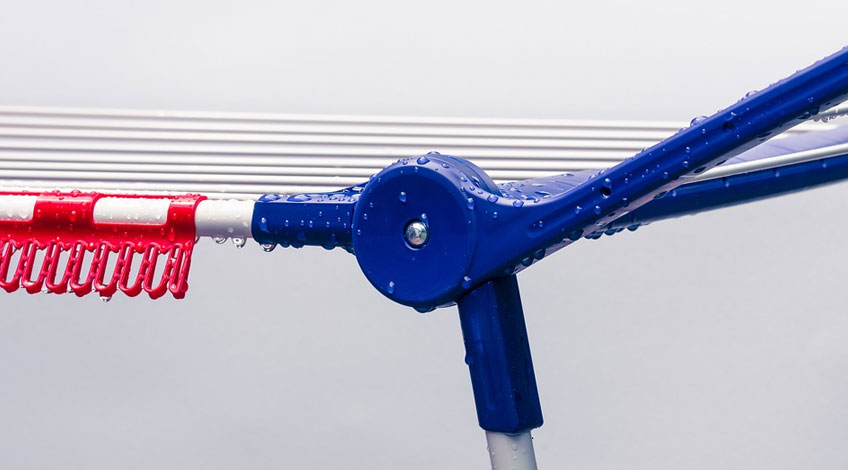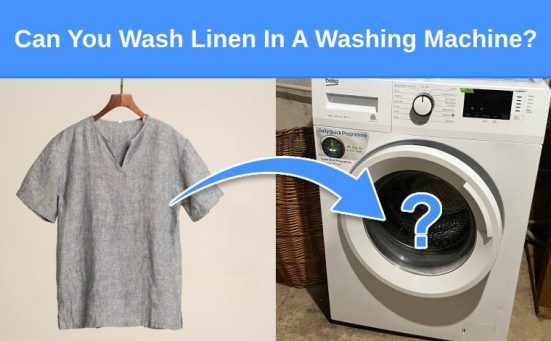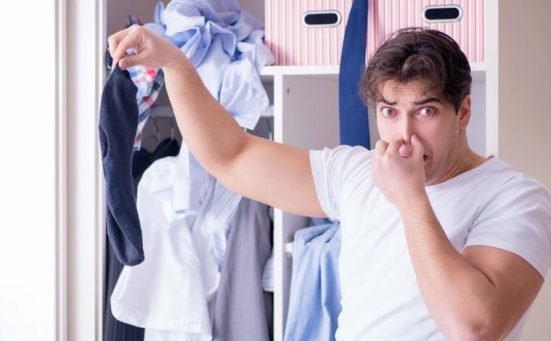
Are Heated Airers Any Good? (and are they worth getting?)
Clothes are always better if dried outdoors on a clothesline. However during our wet and windy winters it’s not often possible to dry clothes outdoors. When considering indoor drying thoughts usually turn to tumble dryers.
But what about heated airers? Are they any good? If you’re looking at alternative ways to dry clothes indoors, keep reading. In this article we look at the pros & cons of heated airers and whether it’s worth getting one for your home.
What Is A Heated Airer & How Does It Work?
A heated airer looks just like a regular airer, it consists of metal (usually aluminium) bars which clothes are either hung on or draped across. The main difference between a regular (non heated) airer and a heated airer is the electronically powered heating element that heats the bars.
It’s this heat that speeds up the drying process by passing through the wet laundry and evaporating water molecules into the surrounding air.
The best heated airers come supplied with a cover that goes over the top once the laundry has been placed on the bars. The cover keeps the heat within the airer which dries the clothes faster as well as keeping any moist air contained as well which reduces any problems associated with damp.
What Are The Advantages Of A Heated Airer?

There are several advantages of using a heated airer which include;
- Reduces The Need For Ironing
As the clothes are either hung from the bars or draped on the racks, they require little to no ironing. - Low Purchase Price
Heated airers range in price from around £40 – £200 which is far less expensive than a tumble dryer. - Low Running Costs
The total cost for running a heated airer for a full 8 hours (the typical drying time) is around 65p to £1.00 depending on the model. - Gets Hot Quickly
The bars heat up rapidly which means clothes are starting to get dry almost immediately. - Doesn’t Cause Any Damage To Laundry
Unlike tumble drying which can be damaging to clothes, a heated airer doesn’t stretch, shrink or tear your laundry. - Packs Away Flat
Although heated airers take up a considerable amount of floor space when set up, once the clothes are dry the airer will fold flat. This allows you to put it away until the next wash day, keeping your floor space free of obstructions. - Can Be Used Anywhere
Unlike a tumble dryer that has a set space, a heated airer can be used in any room of your home. - Requires No maintenance
You never have to do any maintenance to a heated airer, there are no filters to clean, water tanks to empty etc. - Silent When Working
A heated airer is silent in operation, unlike a tumble dryer which can be extremely noisy. However there are some models that use a fan to distribute the heat around the laundry which can be noisy. - Comes In A Number Of Styles
There’s no one size fits all when it comes to heated airers. There are small, medium and large heated airers available some with side flaps others with extended bars. This means there will definitely be a heated airer that will suit your requirements.
What Are The Disadvantages Of A Heated Airer?
The disadvantages of a heated airer include;
- Long Drying Time
It can take upwards of 8 hours to get your laundry dry using a heated airer. Having said that, it is perfectly safe to leave the heated airer running through the night which means the laundry should all be dry when you wake up. - Requires A Large Amount Of Space
The heated airer does need a large area to be spread out into. This can make it impossible to use the room that the airer is set up in. - It Takes A Lot Of Work To Load & Unload
Unlike the tumble dryer where the laundry is all bundled in and left, you need to place each item on the bars of the heated airer and turn them half way through the drying time and then remove them once they are dry. - Can Contribute To Damp In The Home
As the heat passes through the clothes, it causes moisture to fill the surrounding air. That moisture then settles on the first cool surface it comes to and condenses into liquid. That can cause mould, rotting woodwork and all of the other problems associated with damp.
What Do You Need To Consider Before Buying A Heated Airer?

There are several factors to consider before buying a heated airer. These include;
How Big Is It?
Heated airers come in a number of sizes ranging from 6 metres of drying space up to 21 metres of drying space. Obviously, large airers can dry more laundry at one time. In fact, 21 metres of drying space is sufficient for drying around 15 kg of laundry in one go.
How Much Does It Weigh?
Small heated airers weigh less typically around 7 kg which makes them easy to carry when empty. Larger models weigh slightly more but are still relatively easy to move around.
The heavier models do have more stability but even small models are unlikely to collapse or fall over.
How Well Has It Been Designed?
The shape of the airer can vary from design to design, ranging from tall, tiered or winged airers. Winged airers take up more space in the room which might not be suitable for small rooms.
Some of the taller models can look imposing and feel like they are overbearing in a small room. However, taller airers allow you the option of drying long dresses and other long, large items.
Other points to look out for include the design of the feet of the airer and the materials used in construction.
How Much Weight Can It Take?
You might assume that all heated airers are strong and durable. But this is not always the case, some of the budget models for example, can be quite flimsy which could make them potentially dangerous if overloaded.
You should choose a sturdy model that is stable when fully assembled and not likely to collapse as soon as a few items of laundry are placed on it.
Does It Fold Flat When Not In Use?
Most heated airers will fold flat when not in use and this is one of their selling points. Many even halve in size when packed down which can be a great bonus when it comes to storage.
Does It Have A Timer?
Almost all heated airers come with a built in thermostat which will cut the power once the required temperature has been achieved. However, some don’t have timers.
Timers are a good feature to have especially if your home has economy 7 electricity. This allows you to set the timer to turn the airer’s heat off once the economy 7 finishes.
How Much Power Does It Use?
The amount of power the heater element uses will determine to some extent, the length of time it takes to dry clothes. The power consumption will also affect the running costs of the airer too. The bigger the wattage, the faster it will get your laundry dry but it will also cost more to run.
Is It A Covered Heated Airer?
Some heated airers come supplied with a cover. The cover is handy for keeping the heat contained within the unit. This concentrates the heat onto the clothes and gets them dryer faster.
An added bonus of using a cover on your heated airer is that it prevents too much moisture from escaping into the room. This can help prevent damage associated with damp conditions like wood rot, peeling wallpaper and mould patches.
If your heated airer doesn’t come supplied with a cover, they can often be purchased separately or you could use a bed sheet instead.
How Much Does It Cost?
Heated airers range in price from around £40 to around £200 depending on the size, design, style, wattage and whether a cover is included or not.
In many cases, the bigger the capacity for drying clothes, the more power the airer will need and this often means the more it will cost too.
However, even if you go for a top of the range heated airer, it will cost less than a tumble dryer and will also use way less electricity to dry your laundry.
Having said that, a heated airer takes far longer to dry clothes than a tumble dryer. In many cases, you could dry 4 wash loads in a tumble dryer in the time it takes to dry one load on a heated airer.
Is It Worth Buying A Heated Airer?

Heated airers are great for drying clothes indoors when the weather’s too bad for outdoor drying.
It will cost far less to buy a heated airer and run a heated airer compared to a tumble dryer. However, a tumble dryer will get clothes dryer much faster and create less damp air in your home.
Heated airers can be folded flat and packed away when not in use and come in a number of different shapes making it easy to find a heated airer that will fit into your home.
Heated airers are more environmentally friendly as they use around 60% less energy than a tumble dryer even taking into account the extra time needed to get clothes dry!
Clothes are also less likely to get damaged on a heated airer compared to the rough treatment and extreme heat of a tumble dryer.
Overall, if you’re looking for a cheap, environmentally friendly, safe way to get your laundry dry indoors, you could do a lot worse than get a heated airer. As long as you’re patient and don’t mind having a large metal frame full of wet washing taking over one of the rooms of your home.
SEE ALSO: Does A Heated Airer Shrink Clothes?
Frequently Asked Questions
It is worth getting a heated airer if you want a cheaper, more environmentally friendly way to dry laundry indoors compared to a tumble dryer.
Heated airers typically use 60% less electricity than a tumble dryer. Some heated airers have the capacity to dry up to 15 kg of laundry for 60% less energy usage than a tumble dryer.
Clothes are less likely to get that damp, musty smell when dried on a heated airer compared to a regular (unheated airer).




